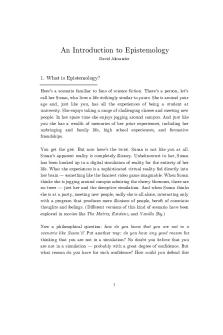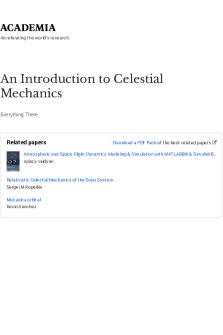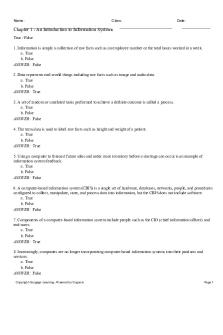1. An Introduction to Glaciers PDF

| Title | 1. An Introduction to Glaciers |
|---|---|
| Author | Joseph Mills |
| Course | Physical Geography |
| Institution | University of Bristol |
| Pages | 6 |
| File Size | 251.6 KB |
| File Type | |
| Total Downloads | 113 |
| Total Views | 173 |
Summary
Lecture 3 of the 'Changing Ice' unit...
Description
An Introduction to Glaciers
Glaciers (ice sheets) ●
●
A mass of snow and ice, which, if it accumulates to sufficient thickness, deforms under its own weight and flows ○ Active glaciers ○ Stagnant glaciers (eventually becomes blocks of ice) Glacier formation ○ Compaction of snowflakes -> granular snow ○ Further compaction and melting/refreezing process -> firn ○ Further compaction -> glacier ice ○ Begins to deform under its own weight ○ Survival of snow over summer depends on sun angle and climate ○ Depends on position on Earth’s surface (large volumes of ice at the poles)
Types of glaciers Defined by their glacial morphology ● ●
Mountain glaciers: cirque, valley, piedmont, tidewater Ice sheets and ice caps
Mountain glaciers ● Flow through valleys ● Cirque glaciers ○ Form right up in the high mountains where there is a bit of depression ○ Shading of the basin prevents a lot of melting ○ Erodes the ‘cirques’ - armchair depressions ● Valley glaciers ○ After enough snowfall and low enough temps, cirque->valley glaciers ○ Can move very quickly (e.g. in Norway) (you can tell as they look mashed up) - they flow too quickly for the ice to deform without fracturing (lots of crevasses) ○ Can also be very flat and not mashed up -> flowing much more slowly, less mass redistribution (e.g. in Svalbard) ● Piedmont glaciers ○ When glaciers flow outside the mountain belt and end up on the coastal plane (e.g. in Alaska) ○ Need low temperatures for mass to be so much that it advances this far ○ Glacier no longer confined by valleys but spreads out ○ Can also occur when flowing into a very large valley ● Tidewater glaciers (Greenland etc) ○ Terminate in the ocean
○
●
●
●
Results in floating tongues - if glacier keeps flowing out into the ocean the tongues become unstable and carve icebergs off the front - how glaciers lose mass ○ Outlet glaciers are the main method of mass transfer from the ice sheet (iceberg production accounts for around 50% of mass loss) Ice shelves ○ In Antarctica there is such cold temperatures that after these glaciers end up in the ocean they can supply very large, flat ice shelves Ice caps ○ Mini-ice sheets ○ Might subsume the topography rather than be constrained by it ○ 30% during glacial periods) ● Hold about 75% of the world’s fresh water (can cause sea level rise) ● E.g. if Greenland were to melt, sea level would rise by ~7m
Cool things about glaciers 1. They store and release freshwaters 2. They move 3. They are alive Glaciers store and release freshwaters ● Glaciers and ice sheets are large, dynamic stores of water that continually exchange mass with other parts of the hydrological system ● Snowfall accumulates, glacier releases this freshwater through melting or iceberg carving ● Mass balance = difference between mass gains and mass losses (indicates health of the glacier) - indicates whether glaciers will retreat or advance ● Accumulation- declines down-glacier (mass gain) ● Ablation - declines up-glacier (mass lost) ● Mass balance is a function of ○ Elevation ○ Climate ○ Local topography ○ Glacier morphology ○ Glacier hypsometry (distribution of terrain area over its elevation range
●
Smaller glaciers, lower elevations = more vulnerable to changes in climatic conditions
Glacier hypsometry - (area/elevation) ● Hypsometry (and altitude) may influence glacier response to climate change - healthy glaciers want more mass at a higher altitude ● Sensitivity of summer melt to temperature is maximum in low-elevation zones Processes of Accumulation ● Accumulation is converted to glacier ice at different rates - dependent on climate ○ Snowfall ○ Wind drift ○ Avalanching (particularly at cirque glaciers) ○ Meltwater freezing ● Accumulation zone includes ○ Dry snow zone (no melting at all, very rare) ○ Percolation zone (tiny bit of melt) ○ Wet snow zone (a lot of melt water) ○ Superimposed ice zone (occasional where water may refreeze onto the ice surface)
● ● ●
Ablation zone - more melting than precipitation ELA - where mass input = mass output, or where accumulation = ablation ELA moves all the time
Why are glaciers continually flowing ● Continual accumulation of mass and distribution around the ELA
● ● ●
Over long time scales glacier flow must balance amount of accumulation and ablation taking place ependent on the pressure and distribution of water at the bed Glacier motion = d = results from the permanent strain of the ice and the glacier bed in response to stress
Mechanisms of glacier motion ● The movement of glacier results from the permanent strain of ice and the glacier bed in response to stress ● 2 main types of stress ○ Normal ○ Shear How glaciers flow 1. Ice deformation ● Results from movement within or between individual ice crystals (creep) - can also get ice fracture ● More deformation at bottom due to weight of layers, but more measurement of flow at the top because it is an addition of all the layers
● ●
Glen’s law measures deformation rate A and n are constants- larger with higher temperatures (quicker deformation)
●
If you have so much flow the crystals can’t form quickly enough and you get fractures
2. Bed formation ● Where glaciers are underlain by soft sediments, ice motion may occur as a result of sediment deformation ○ Strain rates highest at top of deforming layer ○ Can result in very high rates of subglacial erosion and deposition ○ Responsible for unstable glacier motion?
3. Basal sliding ● Describes the process of slip between the glacier sole and its bed ● Basal ice must be at the pressure melting point (i.e. wet)
●
2 main parts ○ Enhanced plastic flow/enhanced creep ■ Creep is enhanced in the vicinity of obstacles due to higher strain rates ■ Ice accelerates over bumps ■ Larger bumps lead to higher strain ○ Regelation sliding ■ Glaciers can slide over their beds by melting on the upstream side of obstacles and freezing on the downstream slide ■ Obstacle must be big enough to allow melting but small enough to allow heat conduction
Velocity variations within glaciers ● Velocities increase from bed to glacier surface ● Velocities increase to the ELA ● Velocities highest at the centre line on valley glaciers (ogives show higher flows at the glacier centreline) ● Variations in width complicate pattern of increase to the ELA Other processes ● Glaciers also erode the landscape ● When glaciers melt, sea level rises and can give way to glacial rias Life ● ●
●
Viable life habitats (liquid water, present locally, snow/ice insulates, sediments supply nutrients) Glacier surfaces ○ Contain microbial microcosms ○ Debris provides nutrients and organic carbon ○ Photosynthesis drives bio-accumulation The basal (subglacial) environment ○ Also habitat to life
○ ○ ○ ○ ●
Dark Liquid water Sediment supplies carbon and nutrients Anoxic conditions
Antarctic subglacial lakes ○ Undiscovered part of the biosphere ○ Microbes have been found...
Similar Free PDFs

1. An Introduction to Glaciers
- 6 Pages

1. An Introduction to Epistemology
- 10 Pages

An introduction to Psychology
- 4 Pages

An introduction to sociolinguistics
- 451 Pages

How to write an Introduction
- 3 Pages

An Introduction to English Grammar
- 324 Pages

An Introduction to Celestial Mechanics
- 217 Pages

An Introduction to Linguistics ( PDF)
- 135 Pages

An Introduction to Well Integrity
- 154 Pages
Popular Institutions
- Tinajero National High School - Annex
- Politeknik Caltex Riau
- Yokohama City University
- SGT University
- University of Al-Qadisiyah
- Divine Word College of Vigan
- Techniek College Rotterdam
- Universidade de Santiago
- Universiti Teknologi MARA Cawangan Johor Kampus Pasir Gudang
- Poltekkes Kemenkes Yogyakarta
- Baguio City National High School
- Colegio san marcos
- preparatoria uno
- Centro de Bachillerato Tecnológico Industrial y de Servicios No. 107
- Dalian Maritime University
- Quang Trung Secondary School
- Colegio Tecnológico en Informática
- Corporación Regional de Educación Superior
- Grupo CEDVA
- Dar Al Uloom University
- Centro de Estudios Preuniversitarios de la Universidad Nacional de Ingeniería
- 上智大学
- Aakash International School, Nuna Majara
- San Felipe Neri Catholic School
- Kang Chiao International School - New Taipei City
- Misamis Occidental National High School
- Institución Educativa Escuela Normal Juan Ladrilleros
- Kolehiyo ng Pantukan
- Batanes State College
- Instituto Continental
- Sekolah Menengah Kejuruan Kesehatan Kaltara (Tarakan)
- Colegio de La Inmaculada Concepcion - Cebu






